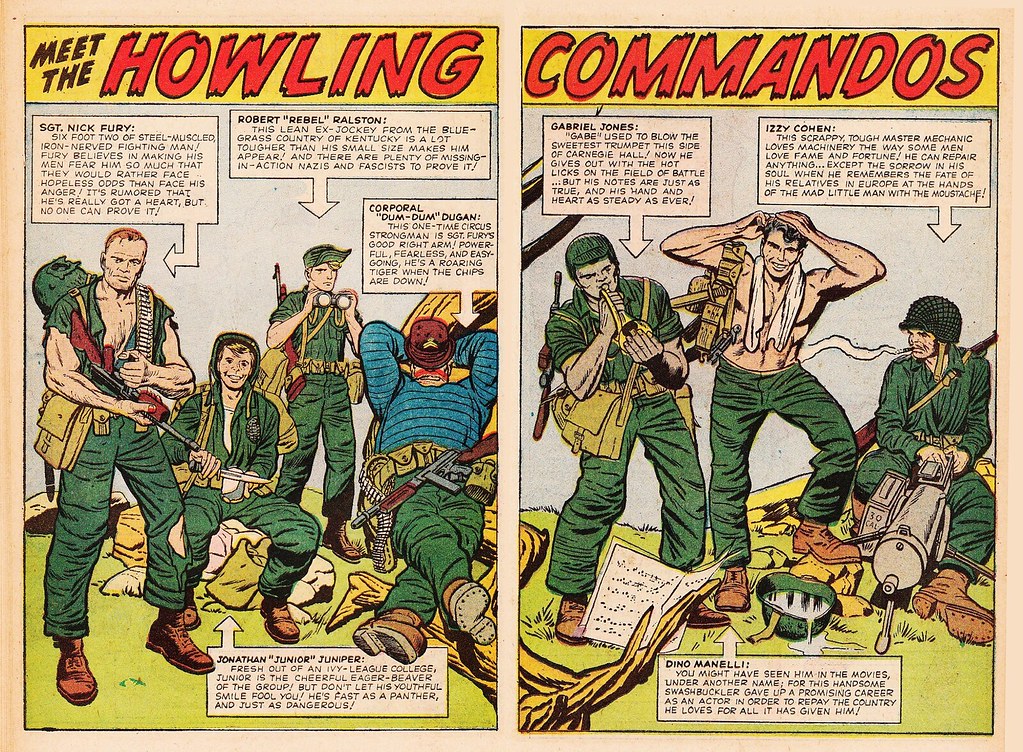Historian Edward Luttwak Tweets:

Afghanistan is very tribal, and much more of a region than a nation-state--see this map, which indicates where various Afghan refugees might be better sent than America:

The American Armed Forces seem to have tried to make the Afghan Armed Forces into the kind of integrated unit you might see in an American WWII movie, or a 1960s cartoon, such as Sgt. Fury and his Howling Commandos:

Fury, above right, is probably Anglo-Saxon, from Hell's Kitchen, in New York. Junior Juniper is a WASP from Connecticut, Rebel Ralston is a white Southerner who's proud of his Confederate heritage, but has no objection to serving alongside black jazz musician Gabriel Jones. Also included: an Irishman, an Italian, and a Jew. (In modern Marvel movies, the role of Fury is taken by Samuel L. Jackson.)
This is fiction—in actual WWII, blacks served in separate units, which did very badly, and occasionally mutinied. But the US nation-state did manage to take men from all over the country and put them in units which were "All-American."
The 82nd Division, formed in World War 1, was the first "All-American" Division, because it was only after trains became a thing that the military could form a division with troops from all 48 states.
Pictured below: Sgt. Alvin York, of Kentucky, who fought the Germans alongside New Yorkers, etc.

Before WWI, the US had locally recruited regiments in the Army, Connecticut and Maine regiments, as the National Guard still does.
In the UK, George MacDonald Fraser did his WWII service in Burma, with a regiment recruited from the North of England, because he lived in Carlisle, which is just south of the Scottish Border.
 The Border Regiment was made up of Englishmen from Cumberland, and Fraser was the only Scot in his section. In spite of the fact that United Kingdom had united England and Scotland as one polity in 1707, and Carlisle is literally within walking distance of Scotland, this led to ethnic conflict, including one fistfight.
The Border Regiment was made up of Englishmen from Cumberland, and Fraser was the only Scot in his section. In spite of the fact that United Kingdom had united England and Scotland as one polity in 1707, and Carlisle is literally within walking distance of Scotland, this led to ethnic conflict, including one fistfight.
Steele was a Carlisle boy, tough and combative and noisy, but something of a mate of mine, even if he did use the word “Scotch” to me with occasional undue emphasis; once he added “bastard” to it (there was no race relations legislation in those happy days), and I responded with a fist; we battered each other furiously until Corporal Little, who was half our size, flew at us with a savagery that took us aback; he knocked me down and half-strangled Steele before dragging us face to face. “Noo shek ’ands! Shek ’ands! By Christ, ye will! Barmy boogers, ye’ll ’ev enoof fightin’ wid Jap, nivver mind each other! Ga on—shek ’ands!” Confronted by that raging lightweight, we shook hands, with a fairly ill grace, which was not lost on him. Then, being a skilled man manager, he put us on guard, together.
But Fraser, though slightly different ethnically from the other Border Regiment soldiers, had actually been born in Carlisle. (Being born in Carlisle doesn't make you not Scottish, assuming you're a MacDonald and a Fraser, any more than being born in Queens, like Omar Mateen, makes you not an Afghan.)
Fraser actually served with men who knew his father: one recognized him in a friendly way, saying "You’re Doctor Willie’s daft son!" After the war, Fraser transferred to a Scottish regiment, in which his great-uncle had served. There was a picture of the great-uncle in a group portrait on the wall of the Sergeants' Mess.
Can you see how this provides for more unit cohesion than either recruiting people from different warring tribes and putting them in same regiment, or picking random people from all over the country?
If so, you're smarter than the Grand Strategists of the Pentagon, such as this guy:
